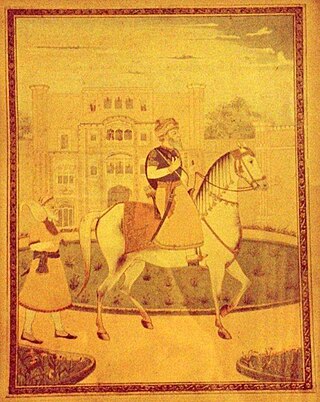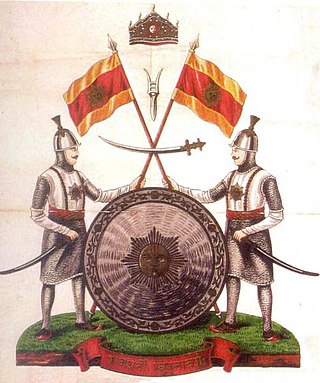
Maha Singh, also spelt as Mahan or Mahn Singh, was the second Sardar of the Sukerchakia Misl, which as a Sikh grouping with its guerilla militia was one of twelve Sikh Misls that later became part of the Sikh Empire. He was the eldest son of Sardar Charat Singh and Sardarni Desan Kaur Warraich. He was the father of Sher-e-Punjab Maharaja Ranjit Singh.

Jassa Singh Ahluwalia was a Sikh leader during the period of the Sikh Confederacy, being the supreme leader of the Dal Khalsa. He was also Misldar of the Ahluwalia Misl. This period was an interlude, lasting roughly from the time of the death of Banda Bahadur in 1716 to the founding of the Sikh Empire in 1801. He founded the Kapurthala State in 1772.
Hari Singh Dhillon was an 18th century Sikh warrior and the chief of Bhangi Misl. During the formation of the Dal Khalsa he was acknowledged as leader of Tarna Dal, and he was made chief of Bhangi Misl following the death of Bhuma Singh Dhillion, who he was an adopted son of, in 1748. Hari Singh made the Bhangi Misl the most powerful of all the Misls. He was described as brave, fearless and a great warrior. Under Hari Singh the Bhang Misl expanded to Jammu, Lahore, Chiniot, Buria, Jagadhari, Firozpur, Kushab, Majha, Malwa, Sandal Bar and Jhang.

Jhanda Singh Dhillon was a chief of Bhangi Misl. Under his leadership the Dhillon family became the dominant de facto ruling power of Punjab. His father was Hari Singh Dhillon, one of the most powerful Sikh warriors of the time. He also had a warrior brother Ganda Singh Dhillon. Jhanda Singh appointed his younger brother Ganda Singh as the commander in chief of the forces. Jassa Singh Ramgarhia was one of the closest friends of Jhanda Singh.

Baghel Singh was a warrior leader in the Punjab region in the northern part of the Indian subcontinent in the 18th century. He rose to prominence in the area around Sutlej and Yamuna. He joined the Singh Krora Misl, one of the Misls during Sikh Confederacy. In 1765, Singh became the leader of the Misl.

Khushal Singh was the second chief of Singhpuria Misl from 1753 to 1795, extending its territory on both sides of the Sutlej River. His 'acquired' lands included Jalandhar, Nurpur, Bahrampur, Patti and Bharatgarh. Jalandhar doab and adjoining areas yielded an annual income of three lakh rupees.

The Dogra dynasty of Dogra Rajputs from the Shivalik hills created Jammu and Kashmir through the treaties with the East India Company following the First Anglo-Sikh war. Events led the Sikh Empire to recognise Jammu as a vassal state in 1820, and later the British added Kashmir to Jammu with the Treaty of Amritsar in 1846. The founder of the dynasty, Gulab Singh, was an influential noble in the court of the Sikh emperor Maharaja Ranjit Singh, while his brother Dhian Singh served as the prime minister of the Sikh Empire. Appointed by Ranjit Singh as the hereditary Raja of the Jammu principality, Gulab Singh established his supremacy over all the hill states surrounding the Kashmir Valley. After the First Anglo-Sikh War in 1846, under the terms of the Treaty of Lahore, 1846, the British East India Company acquired Kashmir from the Sikh Empire and transferred it to Gulab Singh, recognising him as an independent Maharaja. Thus, Jammu and Kashmir was established as one of the largest princely states in India, receiving a 21-gun salute for its Maharaja in 1921. It was ruled by Gulab Singh and his descendants until 1947.

The KanhaiyaMisl was one of the twelve misls of the Sikh Confederacy. It had been founded by Sandhu Jats.

The Bhangi Misl was a large and powerful Sikh Misl headquartered in Amritsar. It was founded in the early 18th century by Sardar Chhajja Singh Dhillon, who was baptised into the Khalsa tradition by Banda Singh Bahadur. The misl received its name "Bhangi" because Chhajja Singh and his soldiers frequently used the herbal intoxicant bhang. It was a first misl to established a Khalsa Raj and publish Khalsa currency coins. The Bhangi Kingdom/Misl was founded by Dhillon Jats.

Sardar Charat Singh, also romanised as Charhat Singh, was the founder of Sukerchakia Misl, father of Mahan Singh, and the grandfather of Ranjit Singh, the first Maharaja of the Sikh Empire. He distinguished himself at an early age in campaigns against Ahmad Shah Abdali and along with 150 horsemen split from the Singhpuria Misl to establish the Sukerchakia Misl, a separate grouping with its distinct guerilla militia.

Sardar Gujjar Singh Bhangi was a Sikh warrior of the Bhangi Misl, and one of the triumvirates who ruled over Lahore prior to the leadership of Maharaja Ranjit Singh.
Manawala is a city in Sheikhupura District, Punjab, Pakistan. It is situated on the Lahore-Sheikhupura-Faisalabad road.
Sardar Gulab Singh was the founder of Dallewalia Misl, one of the sovereign states of the Sikh confederacy that rose during the 18th century in the Punjab region. The Dallewalia and Nishanwalia Misl were stationed as a reserve force at Amritsar to protect the holy city and tackle any emergency. The Amritsar and the Punjab region was subject to raids by the Afghans led by Ahmad Shah Abdali therefore the Sikhs had created misls to defend the Punjab region and push back the invaders.

Haqiqar Singh Kanhaiya was the cousin of Jai Singh Kanhaiya, founder and leader of the Kanhaiya Misl, a grouping of Sikhs with a distinct guerrilla militia. He founded a village named Sangatpur.

The Hill States–Sikh wars, also known as the Sikh–Pahari Raja wars, was a set of battles and conflicts fought by the Sikhs and the rajas (kings) of the Hill States located in the Sivalik Hills.
The siege of Multan was a battle fought between the Sikh forces led by Jhanda Singh Dhillon and the Afghan forces led by Shuja Khan.
Mughalchak is a town in Gujranwala District, Punjab, Pakistan.
The Battle of Jammu was fought in 1774 between Raja Ranjit Deo of Jammu, supported by Jhanda Singh Bhangi of the Bhangi Misl, and Brij Raj Deo, who was allied with Charat Singh Sukerchakia of the Sukerchakia Misl and Jai Singh Kanhaiya of the Kanhaiya Misl. The conflict arose from a succession dispute between Ranjit Deo and his eldest son, Brij Raj Deo. It took place in the Jammu region, part of the northern territories of the Indian subcontinent.
The Dev Dynasty was an important dynasty of Jammu and they ruled for many centuries in Jammu between Chenab and Ravi rivers.
Ranjit Dev was an important ruler of Deva dynasty of Jammu. Jammu State was situated between Chenab and Ravi rivers. He ruled Jammu between 1733 and 1782. During his time Jammu was sacked by Sikhs of Bhangi Misl and became its tributary. He was succeeded by Raja Braj Dev.











